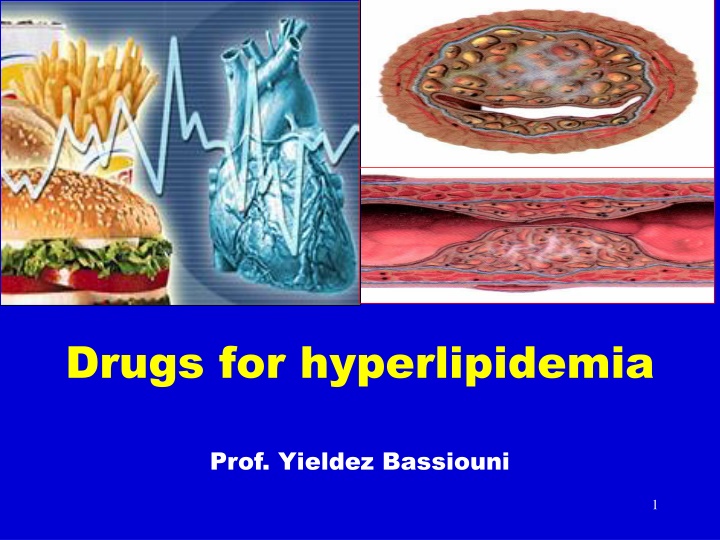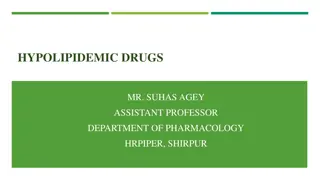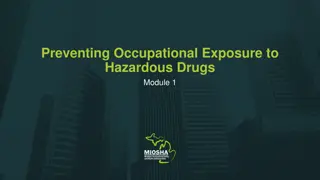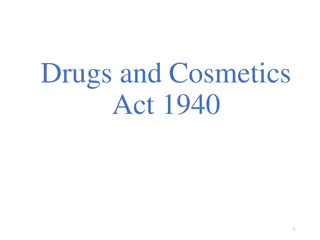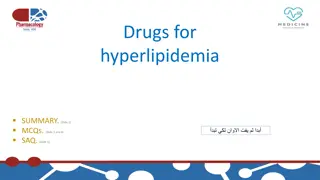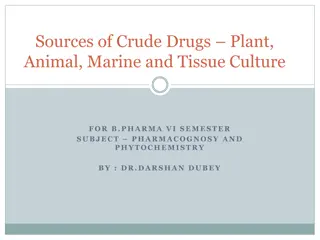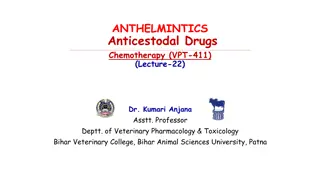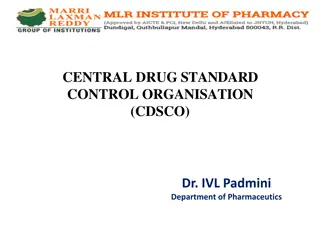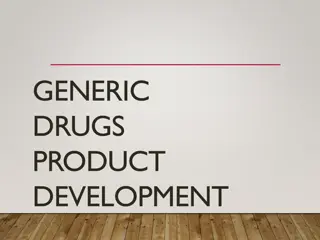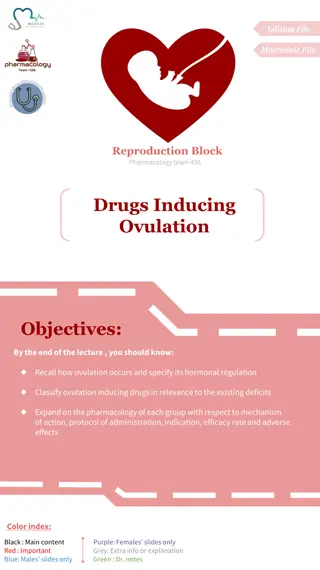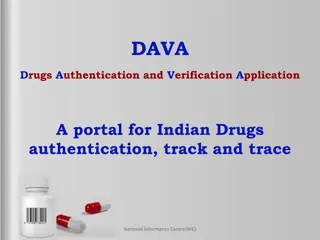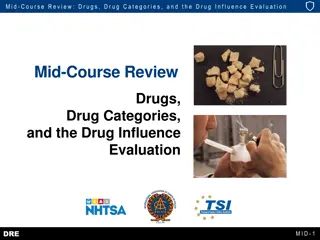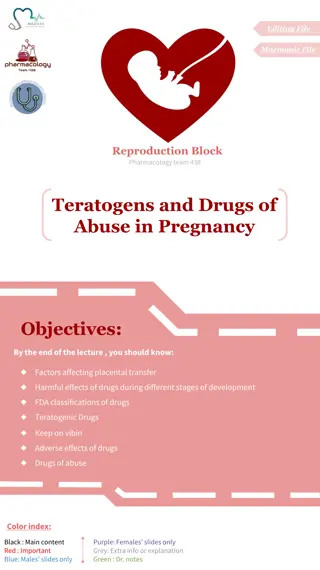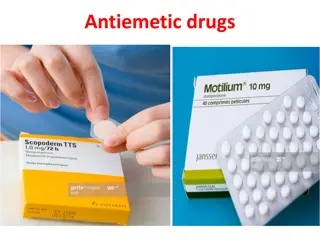Drugs for hyperlipidemia
Hyperlipidemia is a condition characterized by abnormal lipid levels in the blood, leading to atherosclerosis. This content covers the definition, non-pharmacological treatment, lipid-lowering agents, pharmacology, and adjuvant drugs for hyperlipidemia. It also discusses lipids, lipoprotein classes, atherogenic particles, normal lipid levels, and factors that promote elevated blood lipids.
Download Presentation

Please find below an Image/Link to download the presentation.
The content on the website is provided AS IS for your information and personal use only. It may not be sold, licensed, or shared on other websites without obtaining consent from the author.If you encounter any issues during the download, it is possible that the publisher has removed the file from their server.
You are allowed to download the files provided on this website for personal or commercial use, subject to the condition that they are used lawfully. All files are the property of their respective owners.
The content on the website is provided AS IS for your information and personal use only. It may not be sold, licensed, or shared on other websites without obtaining consent from the author.
E N D
Presentation Transcript
Drugs for hyperlipidemia Prof. Yieldez Bassiouni 1
ILOs By the end of those 2 lectures the student will be able to: Define hyperlipidemia vs normal lipid levels Discuss the non-pharmacological treatment of hyperlipidemia Classify lipid lowering agents targeting exogenous & endogenous pathways Expand on the pharmacology of drugs related to each group Hint on adjuvant drugs that can help in lipid lowering 2
Hyperlipidemia Hyperlipidemia is a major cause of atherosclerosis which may lead to CAD and ischemic cerebrovascular disease Denotes abnormally levels of any or all Lipids and/or Lipoproteins [LP] in blood Lipids originate from two sources: endogenous lipids, synthesized in the liver exogenous lipids, ingested and processed in the intestine The principle lipids in the blood are: - Cholesterol (C) - Triglycerides (TG) - Phospholipids (PL) - Cholesterol esters (CE) - Non-estrified fatty acids (NEFA) 3
Lipoprotein Classes - Endogenous molecules that contain both proteins and lipids in their structure - transport (carry) lipids around the body in the blood 4
LP Chylomicrons [CM] Very low Density lipoprotein [VLDL] Low Density lipoprotein [LDL] High Density lipoproteins [HDL] Apoprotein OuterCoat Phospholipids Cholesterol Hydrophilic Gps. Inner Core Triglycerides Cholesterol esters Lipophylic Gps. -Lipoproteins are classified into five major families which differ in the amounts of C, TG and types of apoproteins they contain -Chylomicrons (CM) -Very low density - lipoproteins (VLDL) -Intermediate - density lipoproteins (IDL) -Low density - lipoproteins (LDL) -High density- lipoproteins (HDL) 5
Normal Lipid levels C < 200 mg/dl TGs < 220 mg/dl LDL < 130 mg/dl (Bad C) HDL > 50 mg/dl (Good C) Lipids levels are detected in serum after a 12-hour fast 7
Factors promoting elevated blood lipids family history of CAD smoking (reduced levels of HDL, cytotoxic effects on the endothelium, increased oxidation of lipoproteins, and stimulation of thrombogenesis) hypertension obesity DM (increased generation of VLDL and free fatty acids presented to the liver) inactivity / lack of exercise alcohol intake( increases TGs) 8
Familial Hyperlipoproteinemia LP LProteinemia Lipids Risk Type I CM TGs - Type IIa LDL C VLDL & LDL TG & C Type IIb Type III IDL TGs & C Type IV VLDL TGs VLDL & CM TGs & C _ Type V 9
Therapeutic strategies for treatment of hyperlipidemia Therapeutic lifestyle changes Antihyperlipidemic agents 1. Healthy diet; optimal Quantitative & Qualitative fat content: Diet has <30% of calories as fat, <7% as saturated fat and <200mg cholesterol/day Avoid trans-fatty acids & acute increase in C intake Use vegetable oils rich in unsaturated fatty acids: oleic acid, linoleic acid & linolenic acids. Diet should also contain plant stanols (interfere with the formation of micellar cholesterol) & soluble fibers Eat food high in antioxidants vitamins 2. Regular exercise 3. Cessation of hazards habits; smoking, alcohol, etc 4. Loss of weight Can achieve a fall in LDL-C of 8-15% but long-term compliance is a problem 10
Antihyperlipidemicagents According to the mechanism of action: 1- Inhibits cholesterol absorption in the intestine Ezetimibe 2-Sequester bile acids in the intestine Exchangeresins 3-Inhibits synthesis of cholesterol Inhibitors of hydroxymethylglutaryl coenzyme A reductase (Statins) 4-Alter relative levels & patterns of different plasma LPs Fibrates, Nicotinic acids 11
I-Agents targeting exogenous cholesterol Ezetimibe Colestipol & cholestyramine II-Agents targeting endogenous cholesterol Statins Fibrates Nicotinic acid III-Adjuvant agents Omega-3-Fatty Acids, Stanols 12
Hepatic Cholesterol Metabolism C synthesized in extrahepatic tissues De novo synthesis Diet Absorption Liver cholesterol pool Secretion of VLDL and HDL Conversion to bile salts/acids Free C in bile 13
I-Agents Targeting Exogenous Cholesterol Colestipol Cholestyramine NPC1L1 Ezetimibe 14
Exchange resins Bile acid sequestrants Bile acid sequestrants Cholestyramine & Colestipol Colesevelam 15
Resins: Mechanism of Action They disrupt the enterohepatic circulation of bile acids16
Bile Acid-Binding Resins Moderately effective with excellent safety record Large MW polymers which bind to bile acids and the acid-resin complex is excreted so their fecal excretion 10 folds prevents enterohepatic cycling of bile acids obligates the liver to synthesize replacement bile acids from cholesterol The liver increases the number of LDL receptors to obtain more cholesterol The levels of LDL-C in the serum are reduced as more cholesterol is delivered to the liver Excellent choice for people that cannot tolerate other types of drugs 17
Resins : Adverse Effects Resins are clinically safe as they are not systemically absorbed GIT upset:abdominal discomfort, bloating, constipation Decreased absorption of: fat soluble vitamins (Vitamin A, D, K) The concentration of HDL-C is unchanged 18
Resins:Drugs interactions Interfere with the absorption of: Statins, Ezetimibe Chlothiazides, Digoxin, Warfarin N.B.wait 1 hour before or 4 hrs after administration of resins Colesevelam has not been shown to interfere with the absorption medications and is a better choice for patients on multiple drug regimens of co-administered 19
Contraindications of resins 1- Complete biliary obstruction ( because bile is not secreted into the intestine) 2- Chronic constipation 3-Severe hypertriglyceridemia (TG >400 mg/dL) ?? The bile acid binding resins can raise triglycerides modestly ( about 5%) and cannot be used if the triglycerides are elevated. 20
Cholesterol Absorption Inhibitors Ezetimibe 21
Cholesterol Absorption Inhibitors LDL Liver Duodenum VLDL EzetimibeX Jejunum Ileum CM Remnant CM Colon 22
Mechanism of action of Ezetimibe Ezetimibe reduces C absorption. Therefore, ezetimibe reduces the flux of C from the intestine to the liver. Because this C is packaged and resecreted by the liver into the blood as VLDL (precursor of LDL in plasma), reduced flux of C to VLDL particles will lower LDL-C. 23
Pharmacological action LDL 20% No effect on steroids, lipid-soluble vitamins, bile acids. TG 8% , HDL 1-4% Pharmacokinetics Absorbed & conjugated in intestine to active glucuronide Reaches peak blood level in 12 14 hours Undergoes enterohepatic circulation Its half-life is 22 hours Most of the drug is excreted in feces 24
Indications As Monotherapy; Primary prevention of low risk of CHD which needs modest LDL As Combination Therapy; safe -With statins; synergistic in moderate/severe LDL -Or If must statin dose because of side effects -Or with other lipid lowering drugs; as fibrates ADRs Not common GIT disturbance, headache, fatigue, artheralgia & myalgia Ezatimibe 25
HMG-Co A Reductase Inhibitors Statins 26
HMG-Co A Reductase Inhibitors Hydroxy MethylGlutaryl-Coenzyme A reductase inhibitors or statins are the most effective and best-tolerated agents for treating hyperlipidemia Statins are considered as first-line drugs when LDL-lowering drugs are indicated 27
Statins: Mechanism of Action Statins are potent competitive inhibitors of 3-hydroxy-3-methyl glutaryl coenzyme A (HMG-CoA) reductase, which catalyzes an early, rate- limiting step in do-novo hepatic C synthesis. Thus, HMG-Co A is not converted to mevalonic acid 28
1- Statins lower blood C levels by inhibiting de- novo hepatic C synthesis 2- The liver compensates by the number of LDL receptors on the surface of hepatocytes (upregulation of LDL- R) 3- This results in removal of LDL from the blood and lowering of serum LDL- C levels 4- Because C is required for the synthesis of (the precursor of LDL-C), production of VLDL 5- Statins cause modest in plasma TG and slight in HDL-C 30
PLEIOTROPIC EFFECTS OF STATINS Beyond cholesterol lowering , recent studies indicate that some of the cholesterol-independent or "pleiotropic" effects of statins involve: improving endothelial function, enhancing the stability of atherosclerotic plaques, decreasing oxidative stress and inflammation, inhibiting the thrombogenic response. Furthermore, statins have beneficial extrahepatic effects on the immune system, CNS, and bone. 31
PLEIOTROPIC EFFECTS OF STATINS Statins: Advantages Pleiotropic effects of statins include improvement of endothelial dysfunction, increased nitric oxide bioavailability, antioxidant properties, inhibition of inflammatory responses, and stabilization of atherosclerotic plaques So statins are drugs of choice in patients with high risk of CV disease, they reduce MI, strokes and mortality Statins are the drug of first choice for treating hypercholesterolaemia and moderate triglyceridaemia LDL 18-55% HDL 5-10% TG & VLDL 10-30% Used alone or with other anti-hyperlipidemic drugs in R/ of elevated plasma levels of LDL-C 32
Statins: Preparations Rosuvastatin (Crestor) Atorvastatin (Lipitor) Simvastatin (Zocor) Pravastatin (Pravachol) Lovastatin (Mevacor) Used alone or with other anti-hyperlipidemic drugs ( ezetimibe ) for treatment of drug- resistant dyslipidaemia 33
Statins: Pharmacokinetics Most statins have a high first-pass clearance by the liver Greater than 95% of most of these drugs are bound to plasma proteins with short half-life Drug-drug interactions involve specific interactions with the cytochrome P-450 drug metabolizing system, especially CYP3A4 All statins are taken orally at bedtime because of hepatic C synthesis is maximal between midnight and 2:00 a.m. , except atorvastatin taken at any time because of its long half-life (14 hours) 34
Indications As monotherapy; 2nd ry Prevention; In all ischemic insults [stroke, AMI, ..etc.] So given from the 1st day of ischemic attack Pry Prevention; 1. Patients with hyperlipidemia and with other risks for ischemic insults. 2. Type IIa Hyperlipoprotinemia. If no control combine (sequestrants / ezetimibe, niacin,.. ) to C As Combination therapy; 1. Mixed dyslipidaemias; added to fibrates or niacin if necessary 2. In diabetics and patients with insulin resistance [metabolic syndrome] because these patients will possess small dense LDL (severely atherogenic) + evident endothelial dysfunction + increased thrombotic profile 35
Statins: Adverse Effects Common side effects: Headache , myalgia, fatigue, GI intolerance, and flu-like symptoms Hepatotoxicity, raised concentrations of liver enzymes (serum aminotransferases) Myopathy (increased creatine kinase [CK] released from muscles) Teratogenicity, statins should be avoided during pregnancy 36
Statins: Drug Interactions Statins potentiate the action of oral anticoagulant and anti-diabetic drugs (by displacement from plasma protein binding sites) Drugs that increase the risk of statin-induced myopathy include: Other antihyperlipidemics ( fibrates ) Drugs metabolized by 3A4 isoform of cytochrome P450: erythromycin, verapamil, cyclosporin, ketoconazole Pravastatin and fluvastatin are the statins of choice in patients taking other drugs metabolized by cytochrome 3A4 system. 37
Statin-induced myopathy Muscle aches, soreness, or weakness associated with an elevation of creatine kinase (CK) , are the best indicator of statin-induced myopathy. Failure to recognize myopathy and to discontinue drug therapy can lead to rhabdomyolysis, myoglobinuria, and acute renal necrosis. serum transaminase can progress to evident hepatotoxicity So lab investigations recommended every 6 month if levels to 3 folds at any time, statin must be stopped then dose adjusted. creatine kinase activity (index of muscle injury) Measured only if myalgia or myositis develops if statin doses / omit combination with fibrates .. up 3-5 folds we 38
Niacin (Nicotinic Acid) Water soluble B-complex vitamin with multiple actions Niacin is the most effective medication for increasing HDL cholesterol levels and it has positive effects on the complete lipid profile It is useful for patients with mixed dyslipidemias Niacin exerts greatest beneficial effects on wide range of lipoprotein abnormalities 40
Mechanism of action: 1. In adipose tissue: it binds to adipose nicotinic acid receptors, this will lead to decrease in free fatty acids mobilization from adipocytes to the liver resulting in TG and thus VLDL synthesis 2. In liver: niacin inhibits acyltransferase-2, a key enzyme for TG synthesis Thus, it decreases VLDL production (decreased TG synthesis and estrification) 3. In plasma: it increases LPL activity that increases clearance of VLDL & chylomicron hepatocyte diacylglycerol Niacin also promotes hepatic apoA-I production and slows hepatic clearance of apoA-I and HDL 41
Pharmacological actions Effect on VLDL: 1) synthesis in liver 2) increased clearance in plasma 3) mobilization of free fatty acids from adipose tissue Effect on LDL: LDL due to reduction in its precursor (VLDL) Effect on HDL: Induces modest increase in HDL-C (The catabolism of HDL can be inhibited by nicotinic acid through a mechanism that is largely unknown) Niacin also promotes hepatic apoA-I production and slows hepatic clearance of apoA-I and HDL VLDL by: 42
Niacin : Adverse Effects The most common side effect is cutaneous flushing, (which is prostaglandin -mediated , can be avoided by low dose aspirin h before niacin) GIT disturbances: Dyspepsia , nausea , vomiting , reactivation of peptic ulcer ( can be decreased if taken after meal) High doses: Reversible liver enzymes hepatotoxicity. Impairment of glucose tolerance overt diabetes uric acid 43
Indications Monotherapy or in combination with fibrate, resin or statin Type IIa, IIb hypercholesterolemia & any combined hyperlipidemia Patient with hypertriglyceridemia & low HDL-C Contraindications Gout Peptic ulcer Hepatotoxicity Diabetes mellitus 44
Fibric acid Derivatives (Fibrates) 45
Fibrates :Mechanism of Action Fibrates are agonists of peroxisome proliferator activated receptors (PPAR ) which are a class of intracellular receptors metabolism They increase genes transcription for lipoprotein lipase (LPL)leading to increased catabolism of TG in VLDL and chylomicrons Examples: Clofibrate & Gemfibrozil & Fenofibrate that modulate fat 46
Fibrates: pharmacological effects LPL activity, which increases clearance of VLDL & chylomicron in plasma A marked reduction in TG (due to stimulation of catabolism of VLDL) FFA uptake by the liver LDL-C uptake by the liver in HDL-C (by increasing the production of the apoprotein components of HDL) excretion of hepatic C in bile , thus endogenous hepatic C synthesis may be decreased 47
Fibrates : Adverse Effects GIT (indigestion, abdominal pain, diarrhea) Myositis : can occur resulting in weakness and tenderness of muscles, use of fibrates with statins is generally inadvisable Gallstones: Clofibrate increases C content of bile, predisposes to gallstones, and its use is therefore limited to patients who have cholecystectomy 48
Indication of Fibrates 1st-line defense for: *mixed dyslipidemia (i.e. raised serum TG and C) * Patients with low HDL and high risk of atheromatous disease (often type 2 diabetic patients) * Patients with severe treatment- resistant dyslipidemia (combination with other lipid-lowering drugs). 49
ADRs 1. G.I.T upset, headache, fatigue, weight gain 2. Rash, urticaria, hair loss 3. Myalagia, Myositis, Rhabdomyolysis Acute renal failure Occurs > -In alcoholics, -If combined with statins -Or In impaired renal function 4. fibrates should be used with caution in patients with biliary tract disease, as they increase the risk of cholesterol gallstones as a result of an increase in the cholesterol content of bile. Interactions They displace warfarin from their protein binding sites tendency anticoagulant dose must be adjusted bleeding They .etc. Give lower doses metabolism of statins toxicity myalgia, myositis, 50
